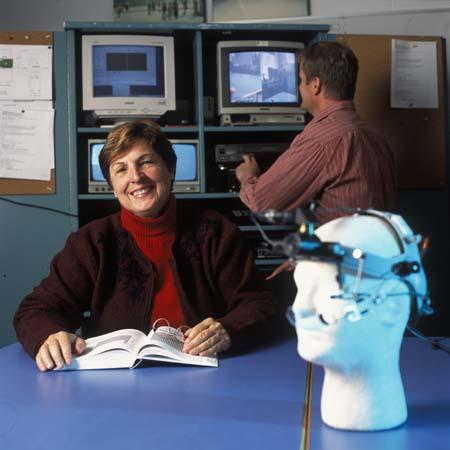
Joan Vickers, PhD, discovered the "Quiet Eye"; the eye tracking device measures the focus of gaze.

Joan Vickers, PhD, discovered the "Quiet Eye"; the eye tracking device measures the focus of gaze.
The Quiet Eye is a phenomenon discovered by Kinesiology researcher Joan Vickers, PhD, that describes how elite athletes focus their attention at crucial moments in a competition, like before taking a shot or making a save.
Vickers has discovered the Quiet Eye in sports such as basketball, soccer, and football, and her principles have been incorporated into non-sporting applications like police officer decision-making training. Her most recent research, published in the American Journal of Surgery, examines the application of Quiet Eye in surgical training.
“What’s really happening during the Quiet Eye period is that the neural networks underlying control of the hands are being organized before performing a critical skill,” says Vickers. “It’s a cognitive slowing down. If you’re a surgeon, you have to focus on very specific locations in the operative field before you execute precise surgical movements.”
In a recent study, researchers tracked the eye movements of three highly experienced and seven less experienced surgeons while they completed a delicate thyroidectomy procedure on cadavers. Researchers were particularly interested in eye movement and focus within the surgical field as surgeons identified and preserved the recurrent laryngeal nerve. Damaging the nerve can lead to significant post-operative complications.
Quiet Eye was measured as the final fixation on the nerve prior to performing dissections. The duration of the highly skilled surgeons’ Quiet Eye averaged over 2.5 seconds, compared to less than a second for the lesser skilled surgeons.
In addition, they found that the expert surgeons focused more on a specific anatomical landmark, the Ligament of Berry, during all phases of the operation, a location that has not been identified in the literature previously. The surgeons used the ligament as a perceptual anchor to help locate the recurrent laryngeal nerve. A perceptual anchor is a central or constant location that is used to determine the relationship of a number of anatomical areas to one another.
“What we have found is that the more experienced surgeons exhibited the same Quiet Eye behaviours as elite athletes,” says Dr. Adrian Harvey, the Alberta Health Services surgeon who led the study. The finding holds promise that Quiet Eye might be another tool that could help trainees become experts sooner in their careers. Medicine has become more complex, yet surgical residents have a limited amount of time to learn their craft. Anything that can enhance the educational process is worth exploring.”